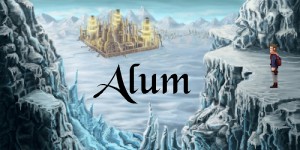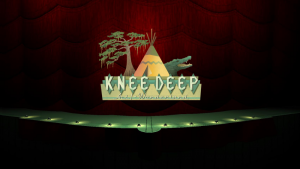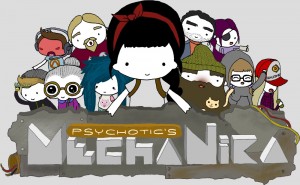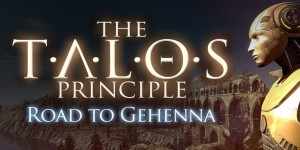Review for SOMA

Two hours into SOMA, I could not get rid of a nagging voice in the back of my head that I’d seen all of this before. The darkened metallic hallways full of blood stains and flickering lights of Alien and Dead Space, the suffocating underwater setting and crazed denizens of BioShock, the renegade AI of just about every science fiction movie ever. It was good, but I hadn’t really been scared yet, the story hadn’t taken off, and everything felt very familiar. I was a little worried.
Why? Well, SOMA is the first game in five years from Frictional Games, who previously released Amnesia: The Dark Descent, arguably the scariest game ever made. My own review of the game called it “nightmarishly, unrelentingly scary.” It popularized the idea – such that it’s now commonplace in the horror genre – of the defenseless player, stripping all combat from the game and leaving players deeply vulnerable. I was excited to see how SOMA planned to one-up the scares of its spiritual predecessor. After two hours, the tentative answer was that it didn’t.
Now that I’ve finished the game, surprisingly the answer is that it never does. But now I know that it was never determined to. There are certainly terrifying moments in SOMA that recall the frantic, heart-racing hide-and-seek sequences of Amnesia, but there are also long stretches of near-calm where different kinds of fear set in: fear of slow death in a hopeless situation, alone at the bottom of the ocean; fear of navigating impossible ethical conundrums; fear of being forced to define where your consciousness ends and your soul begins.
In other words, SOMA sails in headier waters than Amnesia and its razor sharp but ultimately shallow haunted house scares. First and foremost, there is a story to tell here, and it is a horror game only because the story being told goes to dark places. This is not Amnesia 3 (assuming you count The Chinese Room’s spin-off A Machine for Pigs). It is a more ambitious game – and incredibly, a more successful one. SOMA may owe a huge debt to its predecessor, but it is very much its own triumph of storytelling and immersion.
You play as Simon Jarrett, who wakes up in a futuristic facility of some sort with no clue as to how he got there. This isn’t a case of – ahem – amnesia, since Simon knows who he is, but he doesn’t know where he is or why he’s there. You’ll soon discover that he is miles underwater in the Pathos-II research outpost, and as one might expect, something has gone horribly wrong. Everyone seems to be dead or missing, and the halls are full of gruesome corpses, insane robots, and a strangely bulbous, almost organic mechanical overgrowth.
Something horrible has happened on the surface as well, and it is very possible that the people on Pathos-II may be the only remaining humans alive – if, indeed, the voices and distant figures you have been hearing and seeing are human. Of course, not everything is roses and sunshine inside Pathos-II, and it is up to you to survive, discover just how screwed you are, and try to protect the last few humans from total extinction – at least, if doing so turns out to be the right thing to do.
What follows is a narrative that slowly unpeels the layers of the situation, each more quietly horrifying than the next. What at first seems like just another decent entry in a long line of dark, abandoned “space-station” horror games carves out a strong identity for itself. This is a story that is less interested in monsters and villains than in the ethical and philosophical questions that great sci-fi can illuminate: what makes us human? Our body? Our mind? Is it better to live in blissful ignorance or miserable understanding? The greatness of SOMA is apparent in the ways that these questions seep into the gameplay rather than simply occupying cutscenes (of which there are none in the game). You are not just told the themes, you embody them. Crucially, you see everything Simon sees in real-time from the moment the game begins to the moment it ends, some nine or ten hours later. His discoveries are your discoveries, his actions are your actions, and his choices are yours too.
The game is played entirely in first-person using standard WASD and mouse controls (though gamepad support is also quite good). As in Frictional’s previous games, there is a focus on the physicality of the world. You don’t just hit a button to grab items off of a desk, you hold down a button to grab the handle of a drawer and move the mouse/thumbstick to pull the drawer open, peeking inside for notes or other inventory items. You don’t just hit a button to open a door, you have to struggle to turn a rusted valve to equalize pressure, then pull down a T-bar switch to deactivate the locks, and finally grab the door handle and drag it open. Everything that isn’t nailed down can be picked up, rotated, or thrown and pushed around, from coffee cups on a desk to severed limbs. Active computers can be used to pull up emails, maps, and other utilities, some of which are necessary for progression and some of which serve to fill out the narrative or simply add atmosphere.
The general flow of SOMA is as such: reach a new part of Pathos-II, receive an objective from Catherine (one of the survivors and your primary contact via intercom) such as retrieving parts to repair a vehicle, and explore that particular station’s dark corridors, watching out for the homicidal machine creatures that roam the halls. You aren’t always in danger – in fact, there is a surprising amount of downtime when there are no immediate threats, and while the game is not void of jump scares it rarely springs enemies on you without warning. Usually the game signals danger by letting you see an enemy in the distance first, or hear them a few rooms over. Your vision also starts to distort (similar to the insanity effects in Amnesia) when enemies are near, letting you know that you need to watch your step.
When enemies are present, the game becomes a sort of simplified stealth game. Stay out of the line of sight of the lumbering monsters, be careful not to knock things over, and so on. The enemy AI is fairly forgiving – you’re pretty much invisible as long as you’re in partial cover and moving slowly. That said, many areas make it nearly impossible to sneak by unseen, which leads to frantic escapes from hideous, shrieking monstrosities that end in breathless sprints to the nearest safe zone and slamming a door shut behind you. Even getting caught doesn’t immediately kill you, but rather leaves you in a weakened, limping state that can only be healed by using sporadically placed glowing nodes in the mechanical overgrowth throughout the station. Get caught a second time, though, and you’re dead, thrust back to the previous autosave checkpoint. But death is relatively rare, checkpoints are pretty frequent, and SOMA is not an especially difficult game. It feels far more hopeless and harrowing than it actually is.
During the safer, quieter moments, the game splits its time between puzzles and slow-burning exploration. The environments are full of notes, photographs, and environmental details that illuminate the lives of the station’s former inhabitants, as well as the state of the world beyond. They’re also full of machines that form the basis of the game’s puzzles. The puzzles in SOMA aren’t exactly head-scratchers, generally falling into a few categories: grab an item from one room and take it a couple of rooms over to plug it into a machine; use a computer to change something in the environment to enable progress; or a combination of the two. Rather than feeling like arbitrary obstacles to slow forward progression, they feel like natural extensions of the narrative. A particularly memorable moment, for example, has you “resurrecting” the brain scan of a dead engineer and placing it in a simulated environment in order to trick the brain scan into revealing a code you need. In order to prevent the scanned engineer’s stress level from shutting down the simulation, you need to manage the variables of the simulation in order to make it a familiar and calming environment. Not only is it a fun puzzle, it also plays on many of the themes of identity and desperate, malleable morality that form the core of the story.
That ambiguous morality comes into play a lot in SOMA, as you’ll be forced into some pretty awful situations during your time on Pathos-II. These moral quandaries aren’t puzzles, and thankfully they are not presented as “good” ending versus “bad” ending choices. In fact, your decisions don’t affect the ultimate outcome of the game, though it would be reductive to say that they don’t matter. For example, about halfway through the game you encounter a robot infused with a copy of the mind of a former station worker. She seems completely delusional, not realizing she is trapped for eternity at the bottom of the ocean. She can’t be convinced that she is a robot. The game gives you the choice to unplug her, ending her misguided lie of a life. But she seems pretty happy, and anyway wouldn’t that be murder? Or would it? I mean she’s not human, right? It doesn’t throw a prompt on screen forcing you to press Y or N to input your decision. The choice just exists. You can pull the plug or not.
Regardless of what you end up deciding, the game doesn’t goad you or judge you. The question is there, the answer is yours. And in that way, the choices very much matter. More than once I stopped in my tracks, staring at the game, weighing out the ethical implications of my actions, starting to make a choice and stopping halfway, reconsidering, then finally gritting my teeth and following through. Rather than receive the instant feedback most games provide (“Clementine will remember that” or “Dark side points earned!”) I was left to stew in the imagined consequences of my decisions.
The rest of the game is exploration. Pathos-II is one of the real stars of the game. It’s apparent how much care Frictional took to ensure that every environment makes real-world sense rather than just throwing in a series of creepy hallways and calling it a day. Each of the station’s individual sites have a unique character, from Upsilon’s thunderous, industrial thermal generators to Theta’s sleek research labs to the windowless isolation of the even deeper sea site Tau. The graphics are wonderfully detailed, with tons of intricate texture work and dramatic lighting. The mundane and the extreme are both believably rendered, from living quarters to deep sea plains to tunnels ravaged by the biomechanical overgrowth that is spreading throughout the station. The standouts are the game’s exterior segments, where you don a diving suit and explore the ocean floor between sites. Immersive details abound: the way light filters down from the ocean surface, the blur of distant geography due to the mass of dust particles floating freely, the schools of fish drifting and darting around you.
The few human characters don’t fare as well and show the game’s indie roots, but they are not distractingly bad, just a little plastic and stiff. The same can be said for their voice acting – there’s quite a bit of it, and it’s never outright bad, but a lot of it comes of slightly flat. Simon, who naturally carries much of the narrative weight, sounds more like… well, someone acting in front of a microphone than a normal guy stuck in a hellish nightmare, though points must be given for having Simon (a Toronto native) speak in an authentic Canadian accent. Catherine is a highlight, easily jumping between emotional extremes: one minute bantering lightly with Simon, the next angrily defending her actions or quietly empathizing with Simon’s fear and confusion. The rest of the acting lies somewhere between fine and pretty good, though Frictional’s strong writing elevates the otherwise unremarkable voice work.
The rest of the sound design is incredible. Amnesia won our year-end award for best sound effects in 2010, and SOMA continues the trend of Frictional’s stunning soundscapes. The groaning metal, screeching alarms, and hissing hydraulics inside the station have a wonderfully harsh chunkiness that can make something as simple as opening a door a startling, tense experience. Outside the station, the effects take on a muted quality, distorted by the diver’s helmet and juxtaposed with Simon’s panicked breathing. Using sound for positional awareness is also crucial to the moments where you’re hiding from or being pursued by an enemy. Crouching in the corner of a room while tracking a nearby predator by its blasts of static-garbled screams and thudding footsteps is both frightening and satisfying. It’s wonderfully immersive, and it absolutely needs to be experienced with a good pair of headphones. The music is pretty standard horror game fare, with lots of squealing strings, industrial banging, and moody synths with a few bursts of melancholy piano. Though sparsely used, it’s extremely effective when present, even if it doesn’t break any new ground.
SOMA is not as scary as Amnesia, or even many other horror games. That doesn’t mean it’s not scary – it certainly has its moments, including one sequence in the middle that left me physically shaking, forcing me to stop for a while and go to a happy place, but that was the exception rather than the rule. But it is a better game; not only better than Amnesia, but just about every other horror released to date. It’s better because the scares work in service of the story rather than the other way around. This is a unique, sobering, harrowing tale of survival that avoids so many clichés of the genre: SOMA doesn’t ask us if we are the real monsters; it doesn’t ponder whether humanity should play God. It asks how sparse and pathetic an existence we are willing to accept if it means continuing to exist at all. It is perhaps the pinnacle of the horror genre when the questions the game raises are scarier than its already terrifying monsters.
Review copy provided courtesy of GOG.com.





__large.png)
__large.png)
__large.png)
__large.png)






















